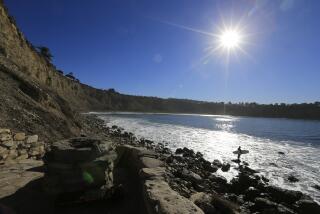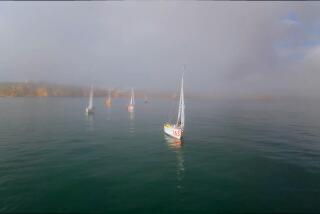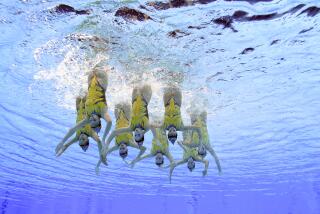Beach Boys Try a Sailin’ Safari : Making waves: Pop group will raise money for an America’s Cup Syndicate. They aim at ’92 Challenge.
- Share via
Let’s go sailin’ now, everybody’s learnin’ how . . . Those natty cats in blue blazers who run the America’s Cup nearly fell off their deck chairs a couple of months ago, when a ’39 Ford Woody with surfboards on top pulled up in front of the yacht club. Five men jumped out, kicked the sand off their feet and asked where they could go to enter the race.
Well, it wasn’t quite like that, but the imagery plays well.
We’re talking fantasy here, and after all, much of what the rest of the world knows about California was influenced from the early 1960s, when the Beach Boys’ recorded musical hits started rolling in like the waves at Huntington Beach.
Surfing was the craze, now the Boys can slide gracefully into middle age and their natural transition: sailing. Change a word here, a beat there and it’s all the same warm sun and salty air:
Everybody’s gone sailin’, Sailin’ USA . . .
The Beach Boys’ USA syndicate is one of three groups hoping to win the right to defend the Cup for the San Diego Yacht Club in trials scheduled to start in January 1992. There were four until Peter Isler’s team dropped out Aug. 29, and the remainder--Dennis Conner, Larry Klein and the Beach Boys--each must show a $6-million stack of chips by Oct. 1 to stay in the game. Eventually, each will need about $15 million to play in this terribly expensive game.
Conner already has his $6 million, and it wouldn’t seem to be a serious order for one of the most successful musical groups ever, except that the Boys don’t have a royalty of their own invested in the project. They won’t even help sail the boat--that’s John Bertrand’s job--let alone clean the bottom.
What they Beach Boys are contributing is their good name and space for sponsors on a concert tour, most of it scheduled for next year. The campaign will get a boost from a sold-out concert Sunday at San Diego Jack Murphy Stadium.
Syndicate Chairman David Lowry said the 1991 tour will do a minimum of 125 dates in 75 cities, including 50 “major markets.”
“It’s not Abilene, Kan.,” Lowry said. “When you see what the Beach Boys are throwing in, it’s staggering.”
For sponsorship packages of $1 1/2 million, $3 million or $5 million, Lowry said, “A corporate sponsor, in addition to everything they get on the boats, gets signing on all handouts of the concerts, signing above the stage, corporate display booths at the concerts, large amounts of tickets to the concerts, backstage passes for the VIPs, photo sessions with the band, hats . . .
“A year before the America’s Cup even takes place, our corporate sponsors are being blasted all over America. The bang you get for a buck with us doesn’t compare to any other syndicate worldwide . . . actually for less money than what Dennis is offering.”
The idea was born on all the impulse of a horn honking at the curb and a shout, “Surf’s up!”
Bertrand and boat designers Doug Peterson, John Reichel and Jim Pugh were sitting around itching to jump into the America’s Cup game. They had the credentials. All they needed was the $15 million.
Peterson knew Lowry, who is a member of the San Diego Yacht Club and a neighbor of Elliott Lott, who is the president of the Beach Boys.
“I’ve known him many years,” Lowry said. “Doug Peterson called me and was frustrated that he and Jim Pugh and John Reichel and John Bertrand had all this talent and weren’t tied into any syndicate, and said: ‘Why don’t you put a syndicate together?’
“I laughed at him. I said, ‘I’m not that foolish’--plus you need a special hook. With the money that’s necessary, trying to do a Dennis Conner-lookalike campaign isn’t going to work.
That was early June.
“I was lying in bed that night and I saw on the side of the boat the Beach Boys with palm trees,” Lowry said. “I called Elliott about 11 at night and said, ‘I’ve got this crazy idea.’ He called me back the next day and said, ‘I like it, let’s talk about it.’
“Within a week, we put the concept together, and the next day we went to meet with the (America’s Cup) Organizing Committee. They looked at us and thought we were crazy, but the more they thought about it, the more they liked it.
“We said, ‘We’ll come back in 30 days and tell you if we’re a go or not.’ We came back in 30 days. That was the day we announced, and the next day they accepted us as a (potential) defender.”
Bertrand said: “We really didn’t want to announce at that time and be lumped in with those groups that weren’t that serious. But we were forced to show our hand, and that was probably good. What we’ve accomplished in three months is quite amazing.”
Catch a wave and you’re sittin’ on top of the world . . .
Bertrand has been there. In 1984, the Newport Beach resident earned an Olympic silver medal in the Finn class, and last year, he sailed Longobarda to the world maxi championship. He also was tactician aboard Courageous in the 1983 America’s Cup campaign and on America II off Fremantle, Australia, in 1986-87.
He learned two lessons from working with skipper John Kolius in the latter campaign--pace and dealing with pressure.
America II, which represented the New York Yacht Club, was the best funded of six American challengers; it pursued an energetic, three-boat development program, and it enjoyed early apparent success, but ran out of steam and failed to qualify for the challenger semifinals. While Conner’s Sail America team continued to refine its boat, America II went, almost literally, dead in the water.
The Beach Boys’ team doesn’t even plan to compete in next May’s world championship for the new America’s Cup class boats, but will build up slowly to a big finish.
“I don’t want to be in the worlds,” Lowry said. “I want to be watching other people’s (boats). I don’t want them looking at mine. We don’t have any intention of having a boat in the water until the end of July next year. We do not need to build a boat for marketing purposes. Dennis (Conner) felt that he needed to build a boat. It was important for fund-raising.”
Bertrand said: “The America’s Cup is a race of technology, and toward the end of the trials, the development accelerates.”
Even before going to Australia, Kolius, given too heavy a load, all but collapsed under the pressures.
“What I learned from that campaign was there are going to be pressures you have to deal with,” Bertrand said. “By surrounding yourself with the right individuals and giving them a lot of responsibility, you don’t have the risk of one individual falling apart. Then the whole program is weakened.
“With John, there is no better teacher out there. I had the opportunity to learn from the best. I hope to take it a step further and improve on what I’ve learned.”
He may ask Kolius to join him on the Beach Boys’ boat.
Reichel and Pugh also designed Abracadabra, which leads the International 50-foot circuit, and Mitch Rouse’s Taxi Dancer, perhaps the best all-round boat among the West Coast ultralight 70s. Nobody knows what they’ll come up with for ’92.
We’ll have fun, fun, fun till our daddy takes the T-bill away ... pichar
She’s my Little Deuce Sloop, you don’t know what I’ve got . . . When Bertrand came home from Australia, he started organizing international sailing programs for others, obtaining designers, assembling crews and planning campaigns.
“It became a livelihood and gave me the opportunity to fine-tune my skills with the idea I would put together an America’s Cup program,” he said.
It was the opposite end of the sailing spectrum from the singlehanded Finns, where he had only to rely on himself.
“Just having the confidence of winning is important. (The America’s Cup) was my first exposure to the team part of sailing, with Courageous. I tackled it as I would in the Finn program, to analyze and cover all my bases.”
Most recently, he has been sailing Windquest on the International 50-foot circuit, with other world-class skippers such as Kolius, Robbie Haines, Rod Davis, Tom Whidden, John Kostecki and New Zealand’s Peter Lester.
“Then this unique opportunity came up with the Beach Boys,” he said.
Bertrand grew up in Sausalito, just across the Golden Gate Bridge from San Francisco, but he was a sailor, not a surfer.
“From age 16 on, I was never there in the summer. I was traveling around the U.S. or Europe. In ‘82, I came to Southern California to train with Courageous in Newport Beach.”
It was there he met Andrea, who became his wife.
pichar
I wish they all could be California girls . . . Bertrand was only 5 on that New Year’s Eve in 1961 when the three Wilson brothers from Hawthorne, cousin Mike Love and friend Alan Jardine mounted the stage of the old Long Beach Municipal Auditorium to perform the only three songs they knew. The appearance launched three decades of nonstop summer fun, fun, fun.
Well, not quite. The late ‘60s and the ‘70s were bummers. In ‘65, Brian Wilson, the band’s inspirational force, became tired of touring and wanted more time to write. He dropped out as an active performer, was replaced by Bruce Johnston on keyboards and later slipped into drug addiction.
He recovered, and in 1983, the band achieved a different kind of popular notoriety when James Watt banned them from their traditional free July 4 concert on the Washington Mall. President Ronald Reagan, a Californian who happened to like the group, reprimanded his Secretary of the Interior, and the episode aroused a strong following from a second generation.
In December of that year, however, Dennis Wilson drowned while diving off a friend’s boat in Marina del Rey. Tests showed he had a blood alcohol level of 0.26--well above more than 2 1/2 times the standard then for being declared legally drunk.
But the boys carried on and in ’88 once again topped the charts with “Kokomo.”
Now it’s debatable whether their America’s Cup involvement will help them or the team more.
“Let’s face it,” Lowry said, “more people are aware of the Beach Boys than they are of the America’s Cup. What they’re getting is a pride in helping to keep the Cup in America.”
Johnston, who wrote the Grammy winner, “I Write the Songs,” may have the most personal interest. He’s a sailor and a member of the Santa Barbara Yacht Club. The connection can’t hurt, but a modern America’s Cup campaign is the most expensive one-shot sports venture on earth.
What the heck . . .
Times researcher Lauri Ferguson contributed to this story.


